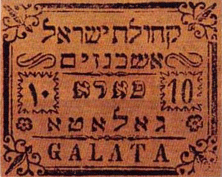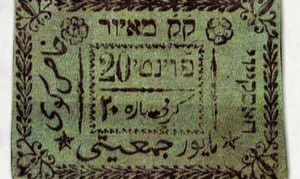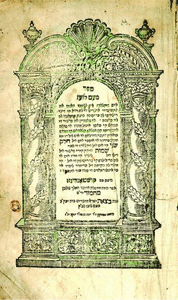Ottoman Synagogue Money and Jewish Printing in the Ottoman Empire
- Written by Admin TOA
- Published in Culture & Art

The Money of Ottoman Synagogue, 19th century, Ashkenaz Synagogue (Tunc Buyurgan, Aykiri Paralar)
The use of paper money (Kaime) during the reign of Ottoman Sultan Abdulaziz (1867-1876) was unsuccessful. In the following years, on the eve of the Ottoman-Russian war, the provision of funding requirements made it necessary for Sultan Murat V to attempt to establish its use again. The Sultan announced the Kaime Regulation to restart printing kaime on August 6th, 1877. However, the new Kaimes were not exchanged for gold and silver. The value of the paper currency began to fall and the public lost confidence in using Kaimes.
A portion of the Kaimes were collected by the Treasury in revenues and removed from circulation, but this time the coinage was also reduced. Because of this, mosques, churches, synagogues, trade associations, and various organizations such as schools and even some private individuals or companies, began printing metal or paper stamps as money.
However, issuing money was a right that belonged only to the state government. To avoid conflict with the law, on scrip issued by non-governmental entities was written that it was "to be used within the group or community."

The money of Ottoman Synagogues,19th century, Haskoy Mayor Synagogue (Tunc Buyurgan, Aykiri Paralar)
Much of the scrip belonged to places of worship, which were usually divided into 4 groups: the Mosques, the Greek Orthodox Churches, the Gregorian and Catholic churches of Armenians, and synagogues.
Tunç Buyurgan, author of the book of Aykırı Para, brought together the dispersed funds from various collections. The Quincentennial Foundation Museum of Turkish Jews exhibited 25 images from digital copies of currency printed by the Ottoman synagogues.
EXHIBITION OF JEWISH PRINTING IN THE OTTOMAN EMPIRE
According to some researchers, the first printing press in the Ottoman Empire was established by the Sephardic Jewish brothers David and Samuel ibn Nahmias. (The date is not certain but it fell between 1493 and 1503)
Under the Ottoman rule, Sephardic Jews grew in the religious literature field and gave great works to the world. Jozef Karo printed the book Shulhan Aruh (Şulhan Aruh),about the foundations of Judaism. Salamon ben Moses ha-Levi Alkabes in Edirne also composed the hymn, the Leha Doli, which is still sung in the Jewish world on the holy Friday night.
In this period, Yakov Kulin began to write Meam Loez, one of his famous pieces. Rabbi Abraham ben İsak Asa became famous as the father of Jewish literature. The Quincentennial Foundation Museum of Turkish Jews in İstanbul exhibits 62 cover pages of printed book from the years 1515-1890.

Pieces were excerpted from the catalog which was printed by the Society of Judaica Collectors Company in Germany. Both exhibits will be open until September 10th, 2009 at The Quincentennial Foundation Museum of Turkish Jews in İstanbul.
THE QUINCENTENNIAL FOUNDATION MUSEUM OF TURKISH JEWS
Karakoy Square, Perçemli Str. (the rear of Selanik Pasaji) 34420 Karakoy / Istanbul
E-mail: This email address is being protected from spambots. You need JavaScript enabled to view it.
Telephone: +90 (212) 292 63 33 / 34
Fax: +90 (212) 244 44 74
Last modified onSaturday, 06 May 2017 10:07
Latest from Admin TOA
- The Young Star of the Gastronomy World Is The New Owner of Samdan
- From Dream to Reality, from Muş to Illinois: Zellano Home, the Largest Furniture Store Under One Roof in the USA!
- 300 migrants to be housed at shuttered Catholic church on Northwest Side in Chicago
- Turkish Philanthropy Funds Hosts 2024 Innovation and Social Impact Summit
- Turkish Stand-Up Sensation Hasan Can Kaya Embarks on U.S. Tour with Art Evi Production, in212 Production, and TAAS New York
